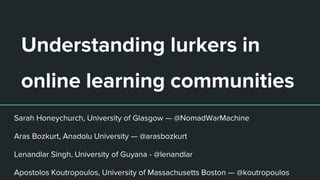
Lurkers
- 1. Understanding lurkers in online learning communities Sarah Honeychurch, University of Glasgow — @NomadWarMachine Aras Bozkurt, Anadolu University — @arasbozkurt Lenandlar Singh, University of Guyana - @lenandlar Apostolos Koutropoulos, University of Massachusetts Boston — @koutropoulos
- 2. Participant Types in MOOCs • Active Participants: Fully participate. • Passive Participants: View course as content to consume, expect to be taught. • Drop-Ins: Become partially/fully active participants for a select topic within the course, do not attempt to complete the entire course. • Lurkers: Enroll, just observe/sample a few items at most. • No-Shows (Hill, 2013)
- 4. Background motivations Why do people lurk in online communities? Lack of confidence? Lack of competence? Something else? Is there one main reason for lurking, or a variety of different reasons? What shifts a lurker into becoming more active?
- 5. Research Questions 1. How is lurking perceived by lurkers? 2. How is contribution defined from the perspective of a lurker? 3. Do lurkers feel part of the community? 4. Why do people lurk (rather than joining in)? 5. What might persuade lurkers to join in? 6. Is lurking a lesser experience than participating, or just a different one?
- 6. Theoretical Framework Community of Practice (CoP) Pareto’s Law (80/20 rule)
- 7. Methodology • Mixed methodology: • first quantitative, then qualitative • Tweeted link to Google Forms • 21 responses, 4 excluded • Identified possible participants with NodeXL • Sent follow up questionnaire Participant Information: 200 course participants in total 80 excluded as “no-shows” 24 active learners 96 lurkers
- 9. Distribution of Learners according to 80/20 rule Harel-Koren Fast Multiscale layout algorithm Blue: 20%; red: 80%; black those accepted to participate online interviews; greens (no- shows: someone mentioned them [kind of invitation to participate] but they never responded)
- 10. Findings • Lurking: • silent/invisible engagement - passive involvement • A type of action • Potential to become visible • Pique interest (time, strength of connection, diversity of topics) “being involved in a passive way: following the ongoing conversation and sharing it with without commenting, expressing opinions and actively engaging in the conversation. Basically, just what I did!” (Participant 4B)
- 11. Findings (cont.) “It depends on the authenticity of your limited interactions with members. Certainly you still learn a lot from conversations, from exploring what others share and their blogs, and from their creativity. I'm happy to appreciate what others create, and to add people to my networks.” (Participant 2) “lurking is a great way to learn, albeit by mostly consuming - there is much to read, save and come back to later, without necessarily completing any or many of the activities.” (Participant 2B)
- 12. Findings (cont.) • Lurkers feel part of the community • Technology plays a role in their level of participation (sophisticated understanding and usage of social media spaces) • Some lurkers have internalized negative attitudes about lurking • Attitudes and views from traditional classrooms carry into Open Online Learning spaces • Lurking seen as a strategy for dealing with competing priorities
- 13. Conclusion • Lurking is complex • Time • Resources • Interest • Cognitive apprenticeship • Develop strategies which lure lurkers into the core of the community?
- 14. Discussion and Q&A • What strategies can we develop to lure in lurkers? • Is luring lurkers in desireable? • Why do YOU lurk? • What would tempt you into more active participation?
- 15. Final slide (we promise!) From: Sarah, Aras, Len, and AK!
Editor's Notes
- Note from aras: quantitative data represents numeric network metrics/ qualitative data represents sociograms (network visuals) and textual interview data
